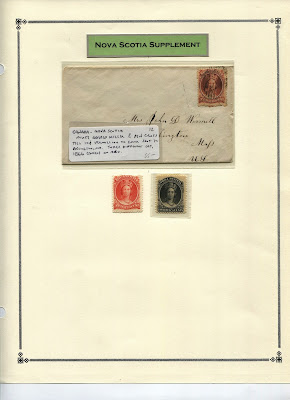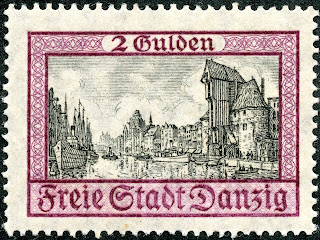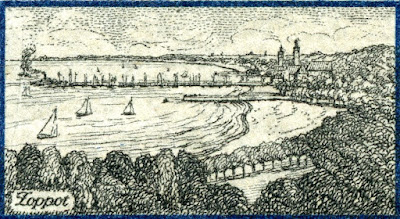Engraved close-up: "Oliva Castle and Cathedral"
1924 Scott 193 1g
Into the Deep BlueThe "Free City and State" of Danzig came under the protection of the League of Nations in 1920.
For more on the background history and the original post, see...
Danzig Blog Post & BB Checklist
The stamp issues are fascinating, and worth a closer look.
1924 Scott 193 1g yellow green & black
"Oliva Castle and Cathedral"
One of the issues that caught my eye is the "Scenes of the Free State" stamps released between 1924-32. They have exquisite line engraving center scenes.
1924 Scott 194 1g orange & gray black
"Oliva Castle and Cathedral"
The 1 Gulden stamps in the issue consist of the Scott 193 "yellow green & black" (2/22/24), the Scott 194 "orange & gray black" (11/28/24), and the Scott 194a "red orange & black" (5/1932). All have watermark 125 (Lozenges).
Of interest, there is a 1938 Scott 233 1g "red orange & black". It is 32.5 X 21.25 mm, while the 1924 example is 31 X 21 mm. The 1938 issue has watermark 237 (Swastikas).
Engraved close-up: "Oliva Castle and Cathedral"
1924 Scott 194 1g
Great scene.
1924 Scott 195 2g red violet & black
"Mottlau River & Krantor"
The 2 Gulden red violet & black was issued 9/22/24.
Engraved close-up: "Mottlau River & Krantor"
1924 Scott 195 2g
The line engraving scene is done well enough, that it wouldn't be out of place hanging in an art museum.
1924 Scott 196 2g rose & black
"Mottlau River & Krantor"
On 11/28/24, only two months since the initial 2g red violet & black stamp was issued, a same denomination 2g rose & black was released. The 2g red violet & black is $45 unused, while the 2g rose & black is CV $3+. Perhaps the difference between CVs is related to the short time the 2g red violet & black was in circulation.
1924 Scott 197 3g dark blue & black
"View of Zoppot"
Don't you agree that Danzig's stamps are particularly well designed? I think it may be due to the popularity of stamp collecting then, and Danzig (as a small entity) could fill it's coffers with money from said stamp collectors if the stamps were attractive to them.
Engraved close-up: "View of Zoppot"
1924 Scott 197 3g
A close up of the 3g center engraving.
1924 Scott 198 5g brown red & black
"St. Mary's Church"
Both the 5g and 10g stamps are considerably more CV expensive "used" as opposed to "unused" (5g: $8+ vs $4+; $110 vs $21).
Engraved close-up: "St. Mary's Church"
1924 Scott 198 5g
Incredible line engraving. No wonder I prefer "classic era" stamps. ;-)
1924 Scott 199 10g dark brown & black
"Council Chamber on the Langenmarkt"
Danzig must have made a "mint", so to speak, with selling there stamps to collectors "unused".
Engraved close-up: "Council Chamber on the Langenmarkt"
1924 Scott 199 10g
Out of the Blue
I hope you enjoyed these enlarged center line engravings. What artistry!
Comments appreciated!



































